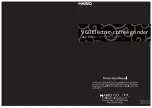
13
GB
Start-up
First slide the tool you wish to use through the
clamping nut
6
before inserting it into the
collet
7
,
26
fitting the tool shaft.
Press and hold the spindle lock
9
.
Insert the collet
7
,
26
into the threaded insert,
then tighten the clamping nut
6
using the
combination wrench
25
on the thread.
Using a tool with clamping mandrel:
Use the screwdriver end of the combination
wrench
25
to loosen and tighten the screw on
the clamping mandrels.
Insert the clamping mandrel in the tool as de-
scribed.
Using the combination wrench
25
, loosen the
screw on the clamping mandrel.
Insert the attachment you wish to use onto the
screw between two washers.
Use the combination wrench
25
to tighten the
screw on the clamping mandrel.
Brick
Do not resharpen any edges by hand with
the brick
21
.
Installing sanding belts
Slide the grinding belt
23
onto the grinding man-
drel
24
from the top. Tighten the screw on the grind-
ing mandrel
24
to secure the grinding belt
23
.
Attaching polishing tools
Turn the polishing attachment
22
on the point
of the mandrel for polishing attachments
32
.
Switching on and off /
Adjusting the speed
Switching on / adjusting the speed:
Set the ON / OFF switch
1
to position „I“ by
pressing down and sliding it forward.
Set the variable speed control
11
to a position
between „1“ and „MAX“.
Switching off:
Set the ON / OFF switch
1
to position „0“.
Using the grip collar with LED light
Hold the spindle lock
9
and unscrew the
clamping nut
6
from the thread, turning coun-
ter-clockwise.
Release the spindle lock
9
.
Then screw the union nut
5
anti-clockwise from
the thread.
Screw the grip collar with LED light
8
onto the
thread, turning clockwise.
Hold the spindle lock
9
and screw the clamp-
ing nut
6
onto the thread, turning clockwise.
Release the spindle lock
9
.
Set the ON / OFF switch of the LED light
36
to
position “I“ to switch it on (see Fig. C).
Set the ON / OFF switch of the LED light
36
to
position “0“ to switch it off again.
Repeat the steps in reverse order to reattach the
union nut
5
.
Information about processing
materials / tool / speed range
Use the router bits to process wood, plastic and
sheetrock at maximum speed.
Determine the speed range for processing zinc,
zinc alloys, aluminium, copper and lead by
testing scrap pieces.
Process plastics and materials with a low melt-
ing point at a low speed.
Process wood at high speeds.
Clean, polish and buff at a medium speed.
Note:
The milling bit
31
is not intended for use on
steel or iron. Suitable milling bits are available.
The following information are non-binding recom-
mendations. When performing the actual work also
test yourself, which tools and settings are ideal for
the material you are working on.
General power tool safety warnings / Start-up














































